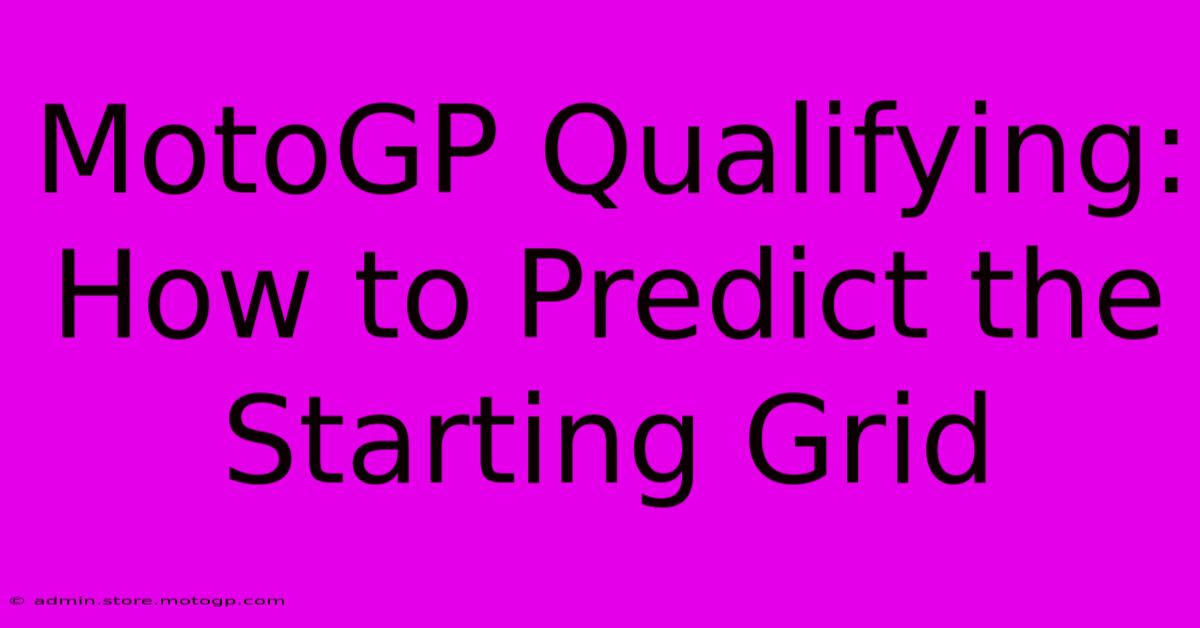MotoGP Qualifying: How To Predict The Starting Grid

Table of Contents
MotoGP Qualifying: How to Predict the Starting Grid
MotoGP qualifying is a nail-biting spectacle, a crucial determinant of race day success. But can you predict who will claim pole position and dominate the front row? While predicting the future is impossible, understanding the factors influencing qualifying performance can significantly improve your predictive accuracy. This guide dives deep into the key elements to help you decipher the starting grid before the lights go out.
Understanding the Qualifying Format
Before diving into prediction strategies, it's vital to grasp the current MotoGP qualifying format. It's a multi-stage process designed to separate the fastest riders from the rest:
- Q1: The slower riders from Free Practice 3 (FP3) compete in Q1. Only the two fastest riders from Q1 progress to Q2.
- Q2: The top ten riders from FP3, along with the two qualifiers from Q1, battle it out for pole position. The grid positions for the race are determined by the finishing order in Q2.
This format introduces an element of unpredictability. A rider struggling in FP3 might unexpectedly shine in Q1, while a seemingly dominant rider could falter under pressure in Q2.
Key Factors Influencing Qualifying Performance
Several factors influence a rider's qualifying performance. Understanding these elements is crucial for accurate prediction:
1. Rider Skill and Experience:
- Racecraft: While pure speed is essential, racecraft significantly impacts qualifying performance. A rider’s ability to navigate traffic smoothly and find clear track space is crucial, especially in Q1.
- Consistency: Consistent lap times throughout the weekend demonstrate a rider's ability to extract the maximum potential from the bike under pressure.
- Experience: Experienced riders often possess a better understanding of tire management and track conditions, allowing them to deliver peak performance at the crucial moment.
2. Bike Performance and Setup:
- Engine Power and Torque: A powerful engine translates to higher top speeds and superior acceleration – critical advantages on specific circuits.
- Chassis Stability and Handling: Excellent handling contributes to consistent lap times and confidence in pushing the bike to its limits.
- Aerodynamics: Aerodynamic efficiency plays a crucial role, particularly on circuits with long straights.
- Tire Choice and Management: Selecting the right tires and managing their wear throughout the session is paramount.
3. Track Conditions:
- Temperature: Track temperature dramatically affects tire performance and grip. Hotter tracks can lead to tire degradation, influencing strategic decisions.
- Weather: Unexpected rain or wind can significantly impact qualifying results, often shuffling the grid.
- Track Layout: Circuit characteristics (corners, straights, elevation changes) influence which bikes and rider styles are best suited to the track.
4. Team Strategy:
- Tire Strategy: Teams will often choose to utilize different tire compounds for qualifying, which can either pay off handsomely or backfire.
- Slipstream Tactics: Utilizing another rider's slipstream during qualifying can provide a significant speed boost.
- Data Analysis: Teams leverage data analysis to optimize bike setup and rider strategies for the qualifying session.
Refining Your Predictions: Beyond the Obvious
While considering the above factors offers a strong foundation, refining your predictions requires a more nuanced approach:
- Analyze Previous Results: Review past performance at the specific circuit. A rider's history at a particular track can indicate their potential.
- Observe Practice Sessions: Pay close attention to FP1, FP2, and FP3. Track times and rider comments can offer clues.
- Follow Team and Rider Communication: Official team and rider communications often reveal valuable information about bike setup and strategies.
- Consider External Factors: Unexpected events (mechanical issues, crashes, track incidents) can significantly influence qualifying.
Conclusion: Predicting the Unpredictable
Predicting the MotoGP starting grid isn't an exact science. However, by carefully considering rider skill, bike performance, track conditions, and team strategy, along with a deep dive into practice session data, you can significantly improve the accuracy of your predictions. Remember, the unpredictable nature of motorsport is part of its thrill, so embrace the uncertainty and enjoy the excitement of qualifying day!

Thank you for visiting our website wich cover about MotoGP Qualifying: How To Predict The Starting Grid. We hope the information provided has been useful to you. Feel free to contact us if you have any questions or need further assistance. See you next time and dont miss to bookmark.
Featured Posts
-
Get Your Hands On A Racing Motorcycle Today
Feb 17, 2025
-
Whats On At Cota Your Concert Guide
Feb 17, 2025
-
Become A Track Star Cota Circuit Days
Feb 17, 2025
-
Moto Gp Photoshoot The Dance Of Speed
Feb 17, 2025
-
Sprint Racing The Future Of Motorcycle Racing
Feb 17, 2025
